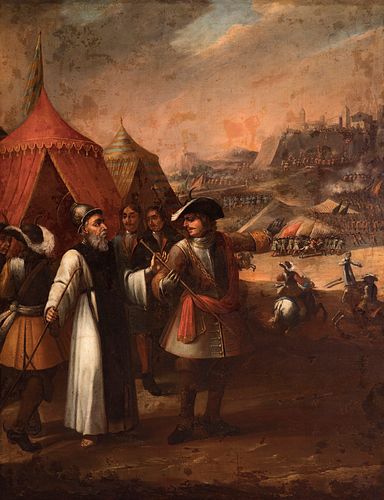Spanish school; first third of the seventeenth century, circa 1700. "War of the Spanish Succession". Oil on canvas. Relined.
Lot 37
About Seller
Setdart Auction House
Carrer Aragó 346
Barcelona
Spain
Setdart Subastas was born in 2004 and is currently the first online art auction in Spain with solidity, prestige and reliability guaranteed by our more than 60,000 users. Setdart has a young, dynamic and enterprising team ready to successfully manage the purchase and sale of art works through custom...Read more
Estimate:
EUR€3,000 - EUR€4,000
$3,225.81 - $4,301.08
Absentee vs Live bid
Two ways to bid:
- Leave a max absentee bid and the platform will bid on your behalf up to your maximum bid during the live auction.
- Bid live during the auction and your bids will be submitted real-time to the auctioneer.
Bid Increments
| Price | Bid Increment |
|---|---|
| EUR€0 | EUR€10 |
| EUR€200 | EUR€25 |
| EUR€500 | EUR€50 |
| EUR€1,000 | EUR€100 |
| EUR€3,000 | EUR€200 |
| EUR€5,000 | EUR€500 |
| EUR€10,000 | EUR€1,000 |
| EUR€20,000 | EUR€2,000 |
| EUR€50,000 | EUR€5,000 |
About Auction
By Setdart Auction House
Nov 3, 2021
Set Reminder
2021-11-03 08:00:00
2021-11-03 08:00:00
America/New_York
Bidsquare
Bidsquare : OLD MASTERS
https://www.bidsquare.com/auctions/setdart-auction-house/old-masters-7786
Setdart Auction House sofia@setdart.com
Setdart Auction House sofia@setdart.com
- Lot Description
Spanish school; first third of the seventeenth century, circa 1700. "War of the Spanish Succession". Oil on canvas. Relined. Presents important faults and repainting. Preserves frame of later period. Measurements: 171 x 132 cm; 188 x 147 cm (frame). In the foreground, displaced to the left of the composition, there is a group of men located outside some stores. The main character, defined by the detail with which he has been portrayed and by his leading position in the scene, directs his hand towards the right side. This is the place where a landscape can be appreciated, composed by means of different shots that provide great depth to the image. In each one of the planes, which make up the background, you can see various military formations, referring to different regiments and at the end, the siege of a city. In spite of being a pictorial recreation of the war, it is evident that the author wanted to show the representation of power, and how it is imposed in a staggered way on all the layers of society. In the first place, the representatives of this power, the church, the crown and the high nobility, discussing how to organize the war conflict, while the lower echelons fight in the conflict. This work expresses to perfection what the full baroque represents, a dynamic, theatrical, narrative and expressive style, supported by a solid handling of light, composition and color. Thus, we see an apparently chaotic scene, although rigorously studied. This type of battle paintings had a wide development, caused by the theme, which not only extolled the victories of those who had participated in the battle. But beyond this testimonial feature, these paintings reflected with their theme, scenes of historical character. A genre that was widely valued, being considered the best in the history of art, for extolling the virtues and the noble spirit of the acts. Due to the clothes worn by the main characters in the scene, it is likely that it is a representation of the War of the Spanish Succession (1701-1714), caused by the death of Charles II, who died in 1700 without any direct descendant, who could opt for the throne. Although weakened by more than a century of continuous conflict, in 1700 the Spanish Empire was still a world power with vast dominions that included the Spanish Netherlands, much of Italy, the Philippines and part of the Americas. Charles' closest heirs were members of the Austrian Habsburgs or French Bourbons; the acquisition of an undivided Spanish empire by either threatened the European balance of power.
- Shipping Info
-
In-house shipping available. Please inquire at admin@setdart.com.
-
- Buyer's Premium



 EUR
EUR CAD
CAD AUD
AUD GBP
GBP MXN
MXN HKD
HKD CNY
CNY MYR
MYR SEK
SEK SGD
SGD CHF
CHF THB
THB

















